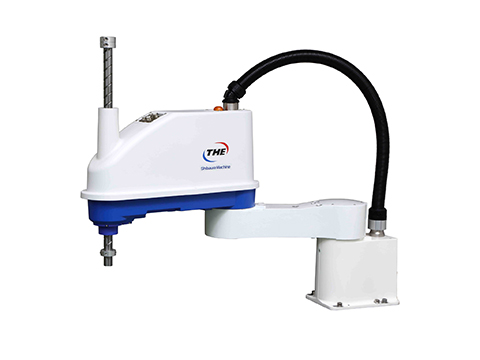
Posted to News on 23rd Apr 2025, 09:06
Sustainability is the new blueprint for robot design
In the world of robot manufacturing, efficiency has always been king. Faster cycle times, greater precision and maximum output have long dictated how industrial robots are designed. But today, a new measure of success is emerging: sustainability. Here, Nigel Smith, managing director of TM Robotics, explores three key factors shaping sustainable robot design.

1. Energy-saving by design
Optimising energy efficiency is one of the most effective ways to make robots more sustainable. In high-speed manufacturing, even marginal reductions in power usage can translate into significant savings over time.
One way robotics engineers are tackling this is by refining how robots move. Shibaura Machine took this approach when designing its latest series of SCARA robots, the THE800 and THE1000. Advanced motion control algorithms were created by engineers to fine-tune acceleration and deceleration, reducing unnecessary energy spikes while keeping operations smooth and precise. The principle is simple but powerful: move smarter, use less energy.
Weight is another major factor. Heavier robots require more power to move, so reducing mass is a straightforward way to improve efficiency. With this in mind, Shibaura Machine designed the THE800 to be 30 kg lighter than its predecessor, the TH850A, without compromising strength. Less weight means less power needed to get the job done - a win-win for both sustainability and performance.
Optimising torque performance is another important consideration. Shibaura Machine used a simulation process to accurately predict torque fluctuations of the THE800 model during various stages of motion. The study identified areas where efficiency could be improved, leading to enhanced motor control and smoother motion profiles. The findings demonstrated how adjusting acceleration and deceleration curves could minimise unnecessary torque peaks, reducing mechanical stress and improving overall efficiency.
2. Reimagining robot materials
Sustainability in robotics isn't just about energy use, it starts at the very first stage of design. That means carefully considering the materials used in construction.
Traditionally, industrial robots are built from a mix of metals and plastics, some of which have a high environmental footprint. However, as manufacturers aim to reduce their Scope 3 emissions - which cover the environmental impact of their supply chain, from material sourcing to end-of-life disposal - there's growing pressure to make smarter choices.
Engineers are now prioritising recyclable materials and finding ways to cut waste during manufacturing. Shibaura Machine has addressed this challenge by using one-dimensional computer-aided engineering (1DCAE) simulations during the latest SCARA development, allowing designers to refine robot structures before production. The result? Less material waste and a more efficient build.
Another crucial aspect is simplifying the architecture of the robot. The fewer components used, the less raw material is needed and the easier the robot is to manufacture, maintain and eventually recycle. The THE800 and THE1000 were developed with streamlined assembly in mind, reducing production waste while maintaining durability and performance.
Similarly, Shibaura Machine engineered the latest TS500-MS robot controller to be 33 per cent lighter than its predecessor, the TS3100. This was achieved through strategic downsizing, material selection and improved connector placement.
3. Building to last
A truly sustainable robot isn't just designed for efficiency, it must also be built to last. Frequent maintenance and part replacements don't just drive up costs for the end user; they also generate waste. That's why modern industrial robots are engineered with longevity as a priority.
This has always been part of Shibaura Machine's robot design philosophy, but the SCARA THE800 and THE1000 take it a step further by prioritising enhanced trajectory accuracy and structural rigidity. Engineers found this approach could significantly reduce wear and tear over the robot's lifespan.
High-quality materials in critical joints and motors also play a role in extending operational life, ensuring robots can handle years of continuous use without excessive degradation. Meanwhile, advanced controllers help smooth out movements, reducing strain on components and minimising the risk of failure. The goal is to ensure the customer will undertake fewer repairs, experience less downtime and ultimately retain the robot for longer.
Evaluating sustainability efforts
Shibaura Machine assessed the environmental impact reductions of the THE SCARA robots using a life cycle assessment (LCA). The study compared the total energy consumption of the THE800 against its predecessor, the TH850A, revealing a 12.9 per cent decrease in electricity use at full load.
When factoring in a 77.7 per cent reduction in total oil consumption and a 39.5 per cent decrease in overall mass, the assessment confirmed an expected 12.8 per cent reduction in total life cycle CO2 emissions.
Sustainability is no longer an afterthought in robotics design, it is a fundamental principle. As industries demand greener solutions, manufacturers must rise to the challenge by creating robots that are not just powerful, but responsible. The goal isn't just to build machines that work faster, but to design automation that works smarter - for both manufacturers and the planet.
Unit 2, Bridge Gate Centre
Martinfield
AL7 1JG
UNITED KINGDOM
+44 (0)1707 290370








